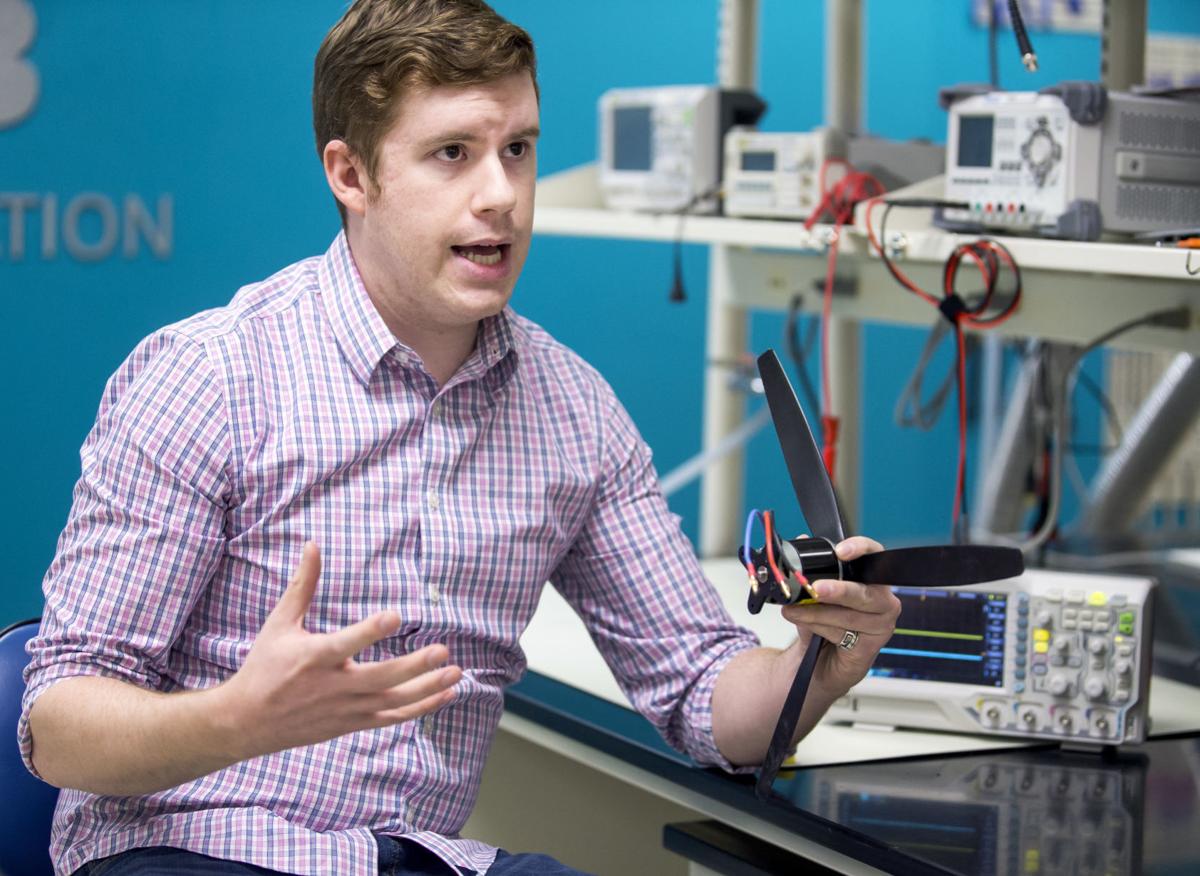As co-founder of Copperhead Aeronautics, Greenberg is trying to perfect and commercialize new designs to power an emerging breed of rotorcraft known as electric vertical take off and landing, or eVTOL, vehicles.
UA Alum's Startup Aims to Supply Engines that put Rotorcraft into the Skies

Phillip Greenberg, a 2015 University of Arizona graduate and founder of Copperhead Aeronautics, says he came up with his idea for rotorcraft lift technology when he was 11. Rebecca Sasnett / Arizona Daily Star
While industry giants like Boeing, Airbus and Uber are working to make personal electric-powered rotorcraft fly for the masses, University of Arizona alumnus Phillip Greenberg hopes his startup company’s performance-boosting technology will ride aboard.
The company’s technology involves specially designed nacelles — essentially, shrouds or cowlings that cover exterior aircraft parts — that maximize lift in eVOTLs.
Greenberg is still working on prototypes for advanced testing at the UA Center for Innovation at the UA Tech Park, the school’s tech-oriented business incubator, where Copperhead became a client in November.
He said an early proof-of-concept study showed the nacelle technology can lift the same amount of weight with nearly 20% less power.
“We build a nacelle coming out of it, and the way we direct the air downward, we can actually create more lift than with the traditional propeller,” said Greenberg, who spent nearly two years as a system engineer for Honeywell Aerospace in Phoenix after earning a bachelor’s degree in aerospace engineering from the UA in 2015.
“For us, this is the engine of lift — you can kind of think of it as a pontoon for a boat, so if you need more buoyancy, you can put another pontoon on it,” Greenberg said.
A former colleague at Honeywell, Ian Wells, is Greenberg’s partner in Copperhead, which was formed in 2016.
Greenberg, who grew up in Albuquerque, said he came up with the idea when he was about 11 years old and started thinking about alternative ways to create flight.
“I remember asking my physics teachers in high school if this could work, and they couldn’t say it wouldn’t,” he recalled.
He continued to pursue the idea and even planned on starting a company around it.
Along the way, he discovered efforts in the 1950s to create airplanes with wings or large flaps that essentially could be folded down to direct airflow from propellers downward, with the deflected slipstream giving vertical lift to allow takeoffs from short runways.
The U.S. Army and NASA’s predecessor agency, the National Advisory Committee on Aeronautics, funded large studies on deflected-slipstream lift technology and several prototypes were built by companies including Ryan Aeronautical and Fairchild Aircraft.
But the experimental aircraft showed stability problems and none reached commercial production.
Greenberg said he believes his company can successfully adapt the idea to rotorcraft.
“We’re able to use newer technology and materials to apply that technology and provide something that’s new and updated,” he said.
There’s a big potential market for Copperhead’s technology.
Companies like Boeing, Bell and Embraer had already invested more than $1 billion in eVTOL technology by the start of 2019, according to the Virginia-based Vertical Flight Society.
Greenberg said he’s aware of more than 90 companies working on eVTOL tech, and the Vertical Flight Society counts more than 130 current experimental eVTOL aircraft.
Some of those prototypes use a “ducted fan” design with a cylindrical propeller shroud, but those are prone to unwanted drag, particularly at higher speeds — something Copperhead’s design minimizes, Greenberg noted.
Major players continue to push eVTOL development, targeting short-hop applications like delivery and air-taxi service.
In June, Amazon announced federal approval to test an autonomous eVTOL delivery drone.
Last week at the Consumer Electronics Show, Korean automaker Hyundai and rideshare giant Uber announced a partnership to develop an eVTOL “air taxi” with a 60-mile range by 2023.
That may be optimistic, since eVTOL makers still face significant technical and regulatory hurdles.
A study last year by Deloitte concluded it will take five to 10 years for eVTOL companies to complete development and work with policymakers to develop regulations allowing applications including air-taxi service, and self-flying drones will take even longer to arrive on account of their technology and safety issues.
Still, Deloitte projects the market for “urban air mobility” eVTOls could reach $3.4 billion in 2025 and grow to $17.7 billion by 2040.
Greenberg said he faces the same issues the big aerospace companies face in scaling up eVTOLs to carry passengers – including developing better batteries to power ever-larger propellers.
“A lot of them are focusing on better batteries,” he said.
“We’re approaching the problem differently, saying, ‘This is the power we have, let’s be more efficient with it.”
While he continues to work on engineering, Greenberg is getting help on the business side from the UA Center for Innovation, which offers office and lab space and mentorship to clients for nominal fees.
Steve Wood, mentor-in-residence at the UACI and Tech Launch Arizona and an electrical engineer with 25 years of entrepreneurial and executive experience, has been helping Greenberg build a management team and develop business plans.
Greenberg said the company may eventually seek investors, but he initially hopes to fund further development with grants, including the federal Small Business Innovation Research (SBIR) program.
He said the company applied unsuccessfully for a NASA SBIR grant a couple of years ago and has applied for a Defense Department grant.
Copperhead ended up signing up as a client of UACI after attending a SBIR “road tour” presentation at the UA Tech Park in August.
Though the Phoenix area has some strong startup resources, Greenberg said he was impressed by UACI staff after wandering into its Tech Park offices after the SBIR program and asking about lab space.
Though he saw only offices, the UACI staff offered to set up a lab where he could do his development work.
“The thing that sold it, coming down here, was the people,” he said. “They were just super accommodating and giving, something that kind of blew me away, honestly.”
Ideally, Greenberg said he’d like Copperhead to become a subcontractor supplying engine components to eVTOL vehicle makers, though licensing the technology to other companies is also a possibility.
“We’d like to partner with large companies, so we don’t want to necessarily be building the vehicles, we want to be building the engines that go on to those vehicles — think GE for jet engines, not Boeing for aircraft,” he said.
Click here to read the original Tucson.com story by David Wichner















